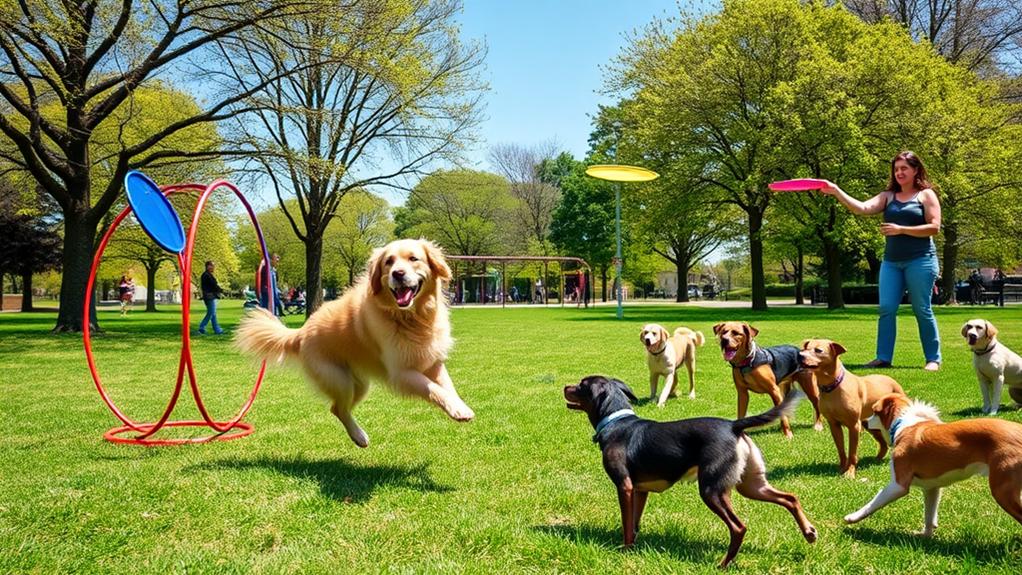Training your dog doesn't have to be a chore; it can be a blast! Start by incorporating playtime into training sessions with games like fetch or tug-of-war. Use positive reinforcement with treats and praise to keep your pup motivated. Keep sessions short—just 5 to 10 minutes—so your dog stays engaged. Introduce fun training games like hide and seek to stimulate their mind. Finally, explore outdoor sessions to make learning exciting with new sights and smells. These tips can transform your training experience, and you'll discover even more ways to enhance the fun for both of you!
Incorporate Playtime Into Training
Incorporating playtime into training can make sessions more engaging for both you and your dog. By blending fun activities with learning, you'll capture your dog's attention and keep them motivated. Start by using toys or games that your dog loves. For instance, you can teach commands like "sit" or "stay" using a favorite ball as a reward. When your dog successfully follows a command, toss the ball for a quick game.
You can also integrate short play breaks between training tasks. This not only keeps your dog energized but also reinforces the idea that training is enjoyable. Consider activities like tug-of-war or fetch, where you can practice commands while having fun.
Another great idea is to create an obstacle course in your yard or living room. Guide your dog through it using commands and reward them with praise or playtime.
Use Positive Reinforcement Techniques

Playtime not only makes training enjoyable but also sets the stage for effective learning through positive reinforcement techniques. This approach encourages your dog to repeat desired behaviors by rewarding them with something they love. Instead of focusing on what your dog does wrong, highlight what's right, and you'll see a positive shift in their behavior.
Here are some key positive reinforcement techniques you can use:
- Treats: Use small, tasty treats to reward your dog immediately after they perform a desired action.
- Praise: Verbal praise and enthusiasm go a long way. Let your dog know they're doing a great job!
- Toys: Incorporate their favorite toys as rewards. A game of fetch can be an excellent motivator.
- Affection: Sometimes, a little cuddle or scratch behind the ears is all it takes to show your dog they've done well.
- Clicker Training: Use a clicker to mark the exact moment your dog performs the desired behavior, followed by a reward.
Create a Training Schedule
Establishing a training schedule can substantially enhance your dog's learning experience. By setting a consistent routine, you create an environment where your dog knows when to expect training sessions, making it easier for them to focus and engage. Aim for short, frequent sessions, ideally 5 to 10 minutes, several times a day. This keeps your dog attentive and prevents boredom.
Here's a simple training schedule you might consider:
| Day | Time | Focus Area |
|---|---|---|
| Monday | 10 AM | Basic Commands |
| Tuesday | 2 PM | Leash Training |
| Wednesday | 5 PM | Socialization |
Adjust the times and focus areas to suit your dog's needs and your availability. Consistency is key; try to stick to your schedule as closely as possible. You'll likely see improvements in your dog's behavior and responsiveness. Plus, it fosters a deeper bond between you and your furry friend. Remember, flexibility is essential, so feel free to tweak your schedule as needed. Happy training!
Introduce Fun Training Games

Training your dog can be both effective and enjoyable when you introduce fun training games into the mix. These games not only keep your pup engaged but also reinforce important commands and skills. You'll find that incorporating play into training sessions helps deepen your bond and makes learning more pleasurable for both of you.
- Hide and Seek: Have your dog stay in one spot while you hide, then call them to find you.
- Fetch with a Twist: Teach your dog to fetch specific toys by name, enhancing their vocabulary.
- Obstacle Course: Set up a mini agility course using household items to encourage your dog to navigate through and around obstacles.
- Simon Says: Use basic commands like "sit," "stay," and "down," but only reward your dog when you say "Simon says" first.
- Treasure Hunt: Hide treats around your home and encourage your dog to sniff them out, stimulating their natural instincts.
These games can turn training sessions into a fun-filled experience, ensuring your dog stays motivated and enthusiastic to learn.
Explore Outdoor Training Sessions

Outdoor training sessions offer an invigorating change of scenery that can energize both you and your dog. Instead of the usual indoor routine, taking your training outside exposes your pup to new sights, sounds, and smells, making learning more exciting. Parks, backyards, or even quiet streets provide the perfect backdrop for engaging training activities.
Utilize the space around you by incorporating real-world distractions into your sessions. Practice commands like "sit," "stay," and "come" amid the natural hustle and bustle. Gradually increase the difficulty as your dog becomes more focused. You can also introduce fun elements like fetch or agility exercises, which keep your dog engaged while reinforcing important skills.
Don't forget to reward your dog with treats and praise for their efforts to maintain their enthusiasm. Remember, training outdoors can also be a bonding experience. Enjoy the fresh air together, and let your dog explore during breaks. This combination of training and play solidifies learning while deepening your connection. So grab a leash, head outside, and watch your dog thrive in a dynamic environment!
Conclusion
By incorporating playtime, positive reinforcement, and a structured training schedule, you can make dog training a fun and rewarding experience for both you and your pup. Don't forget to introduce engaging training games and explore outdoor sessions to keep things exciting. Remember, the more enjoyable the training process is, the more likely your dog will learn quickly and stay motivated. So, get out there and turn training into an adventure you both look forward to!



